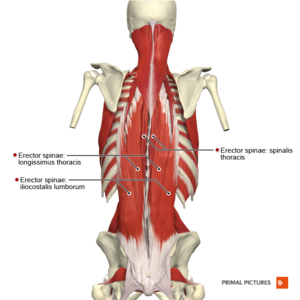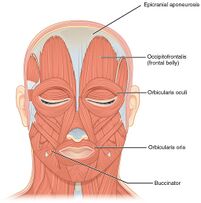Aponeurosis: Difference between revisions
No edit summary |
No edit summary |
||
| Line 13: | Line 13: | ||
== Erector Spinae Aponeurosis == | == Erector Spinae Aponeurosis == | ||
[[File:Muscles of the back erector spinae group Primal.png|right|frameless]] | |||
The erector spinae aponeurosis (ESA) is a common aponeurosis that blends with the thoracolumbar fascia, with a proximal attachment on the sacrum an the spinous processes of the lumbar vertebrae, for the three erector spinae muscles (iliocostalis, longissimus, and spinalis) and overlying the inferior portion of the erector spinae muscles.<ref>IMAIOS Erector spinae aponeurosis - Aponeurosis musculis erectoris spinae Available:https://www.imaios.com/en/e-Anatomy/Anatomical-Parts/erector-spinae-aponeurosis (accessed 15.12.2021)</ref> | The erector spinae aponeurosis (ESA) is a common aponeurosis that blends with the thoracolumbar fascia, with a proximal attachment on the sacrum an the spinous processes of the lumbar vertebrae, for the three erector spinae muscles (iliocostalis, longissimus, and spinalis) and overlying the inferior portion of the erector spinae muscles.<ref>IMAIOS Erector spinae aponeurosis - Aponeurosis musculis erectoris spinae Available:https://www.imaios.com/en/e-Anatomy/Anatomical-Parts/erector-spinae-aponeurosis (accessed 15.12.2021)</ref> | ||
Revision as of 05:31, 15 December 2021
Original Editor - User Name
Top Contributors - Lucinda hampton, Kim Jackson and Ahmed M Diab
Introduction[edit | edit source]
Aponeuroses are sheet-like elastic tendon structures that cover a portion of the muscle belly and act as insertion sites for muscle fibers while free tendons connect muscles to bones[1]. They have a role similar to a tendon but here is how they differ:
- An aponeurosis looks quite different than a tendon. An aponeurosis is made of layers of delicate, thin sheaths. Tendons, in contrast, are tough and rope-like. An aponeurosis is made primarily of bundles of collagen fibers distributed in regular parallel patterns, which makes an aponeurosis resilient.
- Aponeurosis has a function of absorbing energy during the movement of the muscle, while Tendon has a function of stretching and contracting during muscle movements.
- It is very rare for the Aponeurosis to get injured as it is situated hidden under many layers of bones and muscles. But Tendon gets injured easily, for it is present in all the injury-prone areas.
- Aponeuroses can act as fascia. Fascia is a fibrous tissue that envelopes muscles or organs, to bind muscles together or to other tissues.[2][3].
Erector Spinae Aponeurosis[edit | edit source]
The erector spinae aponeurosis (ESA) is a common aponeurosis that blends with the thoracolumbar fascia, with a proximal attachment on the sacrum an the spinous processes of the lumbar vertebrae, for the three erector spinae muscles (iliocostalis, longissimus, and spinalis) and overlying the inferior portion of the erector spinae muscles.[4]
The thoracolumbar fascia (TLF) and the erector spinae aponeurosis (ESA) play significant roles in the biomechanics of the spine. The ESA, at twice the thickness of the pTLF, is the thickest dense connective tissue (mean thickness: 1.85 mm) of the paraspinal compartment. [5]
Epicranial Aponeurosis[edit | edit source]
The epicranial (or galea) aponeurosis is a tough fibrous sheet of connective tissue that extends over the cranium, forming the middle (third) layer of the scalp. The epicranial aponeurosis also contains vessels that communicate between the deep vascular plexus contained within the subgaleal layer below as well as the superficial vascular plexus in the subcutaneous layer above[6].
Image : epicranial aponeurosis.
Plantar Aponeurosis[edit | edit source]
The plantar aponeurosis (PA) originates from the calcaneal tubercle and extends to the forefoot. The aponeurosis consists of a medial, central and lateral part.
- The medial and lateral parts attach to the abductor hallucis and the musculus abductor digiti quinti pedis, respectively. These parts are usually categorized as “fascia”.
- The central part is thicker and is considered an “aponeurosis”.
As the central aponeurosis extends towards the forefoot, it divides into five separate bundles. These bundles radiate towards and attach through the plantar plates to the proximal phalanges.
One function of the PA is to support the foot arch[7]
- bulleted list
- x
or
- numbered list
- x
References[edit | edit source]
- ↑ Arellano CJ, Gidmark NJ, Konow N, Azizi E, Roberts TJ. Determinants of aponeurosis shape change during muscle contraction. Journal of biomechanics. 2016 Jun 14;49(9):1812-7. Available:https://pubmed.ncbi.nlm.nih.gov/27155748/ (accessed 15.12.2021)
- ↑ Study.com Aponeurosis Available: https://study.com/academy/lesson/aponeurosis-definition-function.html (accessed 15.12.2021)
- ↑ Ask any difference Aponeurosis and tendon Available:https://askanydifference.com/difference-between-aponeurosis-and-tendon/ (accessed 15.12.2021)
- ↑ IMAIOS Erector spinae aponeurosis - Aponeurosis musculis erectoris spinae Available:https://www.imaios.com/en/e-Anatomy/Anatomical-Parts/erector-spinae-aponeurosis (accessed 15.12.2021)
- ↑ Creze M, Soubeyrand M, Timoh KN, Gagey O. Organization of the fascia and aponeurosis in the lumbar paraspinal compartment. Surgical and Radiologic Anatomy. 2018 Nov;40(11):1231-42.Available: https://pubmed.ncbi.nlm.nih.gov/30171298/(accessed 15.12.2021)
- ↑ Radiopedia galea Aponeurosis Available:https://radiopaedia.org/articles/galea-aponeurotica (accessed 15.12.2021)
- ↑ Chen DW, Li B, Aubeeluck A, Yang YF, Huang YG, Zhou JQ, Yu GR. Anatomy and biomechanical properties of the plantar aponeurosis: a cadaveric study. Plos one. 2014 Jan 2;9(1):e84347.Available: https://www.ncbi.nlm.nih.gov/pmc/articles/PMC3879302/(accessed 15.12.2021)








